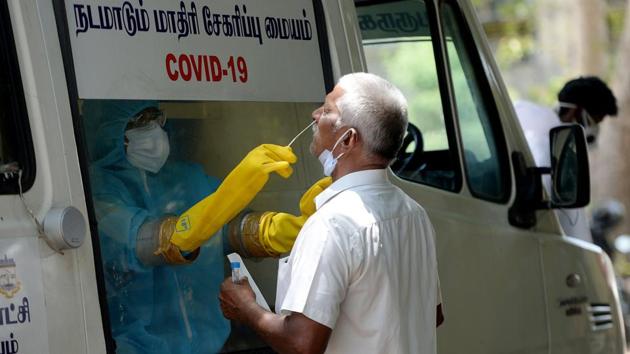Covid-19 in India: Time for bold experimentation
Involve the private sector in testing; ramp up the contact tracing apparatus; invest in research; experiment widely
To counter the Covid-19 crisis in India, many have recommended raising the annual health expenditure, primarily for testing, tracing, isolation, and universal mask-wearing. This view places financing above governance concerns that lie at the heart of the health care sector in India. The availability of more resources might not be sufficient for the country to implement a Vietnam, Tamil Nadu or Kerala model across all states. While we have been demanding greater health spending for nearly two decades, varying State capacity to implement programmes remains a fundamental constraint. For example, a recent study in The Lancet Global Health, on national, regional, and state-level all-cause and cause-specific under–five mortality (2000–2015), revealed large variations across states, ranging from 9.7 deaths in Goa to 73.1 deaths in Assam (per 1,000 live births). These disparities cannot be explained as being due to the shortage of health funds alone, as the study highlighted that; “…evaluation of health initiatives shows varying programme governance and accountability across states. Therefore, high and consistent commitment from local government is crucial to ensure that programmes work as intended.”

In the current pandemic, ubiquitous testing seems logical and necessary. There are, however, several practical considerations which suggest alternative interventions. Research from the previous SARS epidemic has shown that there was wide variability in individual infectiousness; 10% of cases were responsible for 80% of the spread, implying that super-spreader events caused outbreaks.
Therefore, we should use the existing contact tracing data to identify if there is dispersion in individual infectiousness, and more important, whether there are identifiable factors that affect the transmission of the disease, such as crowded working conditions, confined locations, age, gender and co-morbidities.We should utilise our existing resources to build relevant local intelligence on transmission, and the testing strategy should be prioritised accordingly. A recent study from Japan also shows how cluster analysis can be used to identify and isolate super-spreaders — thereby containing the overall outbreak.
The role of the private sector is critical for India to control this pandemic. If firms are to function under the current uncertain environment, then there is a possibility of a Coasian bargain between an employer and employee to mitigate the risk of infection. Market solutions will emerge with a willingness to pay for testing, masks, and enforcing strict social distancing norms. We must explore alternative mechanisms where the private sector pays to mitigate uncertainty. Moreover, the prevalence elasticity of demand for self-protection also means that demand for self-protection will go up significantly. Government testing should then perhaps focus on areas where market-based solutions will not work.
Beyond testing, it is important to put more thought and resources into contact tracing efforts. Research on the Ebola virus has revealed that delayed and ineffective contact tracing was a significant contributor to the outbreak in 2014–2015. Challenges include identification of all contact persons; this requires investigation and probing skills. In Kerala’s Kasaragod, the local police played an essential role in effective contact tracing. Given their training in debriefing and verification, local police personnel are naturally suited to extensive contact tracing. Therefore, what is needed are special personnel with skills in contact tracing that could be hired temporarily at the level of a police station. Another challenge is the logistical issue of physically tracing the identified person, mainly, where addresses are not well-defined. This requires extensive use of technology such as monitoring call and Internet data records, and in some cases, CCTV footage to physically identify persons concerned. After all this, the traced people have to be assessed daily for a significant period, which requires cooperation, willingness and, most important, trust. Management and performance of contact tracers must also be addressed upfront. While there have been suggestions about using additional ASHA workers, this is based on the assumption that optimal tools for contract tracing exist, and what is needed is for ASHA workers to merely learn these tools and implement them on the ground. Our experience with contact tracing in this pandemic suggests that the ministry of home affairs (MHA) has to work closely with the ministry of health. Given the significance of contact tracing, standard operating procedures (SOPs) are required to be developed by MHA. SOPs should be circulated across local police stations and health departments.
Most important, this crisis could be an opportunity for policymakers and researchers to work together and exploit insights from epidemiology and other observational studies to design a series of ethical, economic and psychological cost randomised control trials as suggested by Haushofer and Metcalf in Science (May 21) to identify “non-pharmaceutical interventions” that could have a significant impact on human health with low societal and economic costs. Interventions range from encouragement and recommendations to regulations and sanctions — which ones work best in a pandemic?
In brief, given that we know so little about what works and what doesn’t, it is time to experiment. We should increase budgetary allocation for research and experimentation and design data-driven policies. In summary, to resolve the uncertainty till a vaccine is discovered and widely available will require several trial-and-error experimentations and a willingness to learn.
advisory council. The article has inputs from Mudit Kapoor of the Indian Statistical Institute
The views expressed are personal






